To go from zero to confident with outdoor proofing, choose sturdy, weather-resistant prep boxes that keep your ingredients and baked goods protected. Maintain a controlled environment by using breathable covers, monitoring temperature and humidity with tools like thermometers, and shielding your dough from wind, sun, and sudden weather changes. Proper setup and adjustments are key, and with more tips, you’ll soon master outdoor proofing with ease and consistency.
Key Takeaways
- Choose weather-resistant, UV-protected, and transparent containers for effective outdoor proofing organization.
- Maintain a controlled environment with proper coverings, shading, and climate monitoring to ensure consistent dough fermentation.
- Protect baked goods from outdoor elements using sturdy covers, pest screens, and sheltered proofing spots.
- Adjust proofing conditions by regulating humidity, temperature, and airflow, considering outdoor weather and city dynamics.
- Regularly inspect and maintain equipment, monitor weather, and plan for backup proofing options to ensure success outdoors.
Choosing the Right Prep Boxes for Outdoor Baking
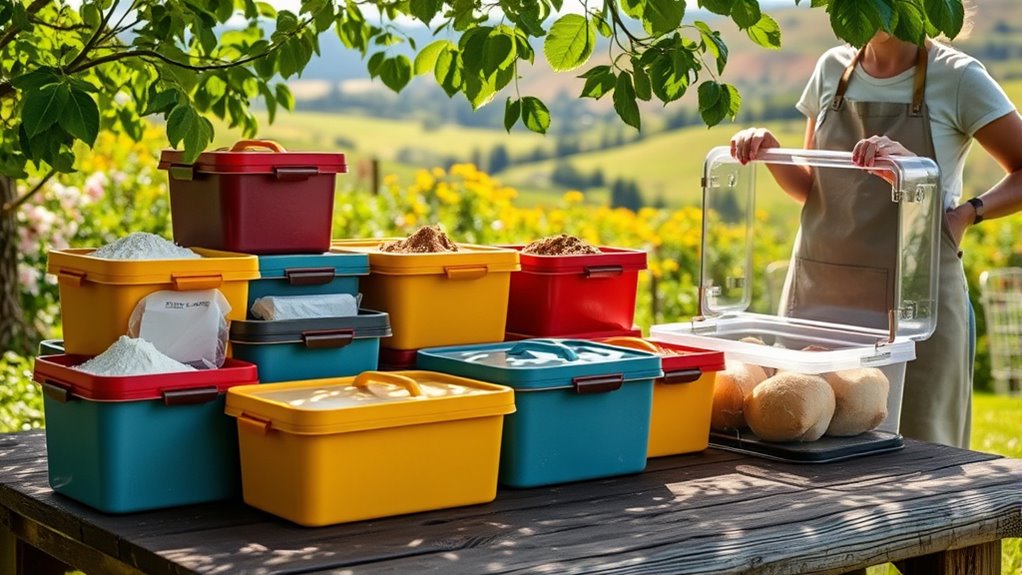
When selecting prep boxes for outdoor baking, you need containers that can withstand the elements while keeping your ingredients fresh and organized. Look for durable, weather-resistant materials like BPA-free plastic or stainless steel that won’t warp or crack. Proper outdoor lighting helps you see clearly when prepping, reducing mistakes and ensuring safety. Pest prevention is also essential; choose sealed lids and containers with tight-fitting closures to keep insects and critters out. Transparent boxes allow easy identification of ingredients without opening multiple containers, minimizing exposure to outdoor conditions. Additionally, stacking features can save space and keep everything tidy. For optimal preservation, selecting UV filters in your containers can help prevent color fading and protect your ingredients from sun damage. By choosing the right prep boxes, you’ll maintain freshness, prevent pests, and create a more efficient outdoor baking setup.
Preparing Your Dough for Outdoor Proofing
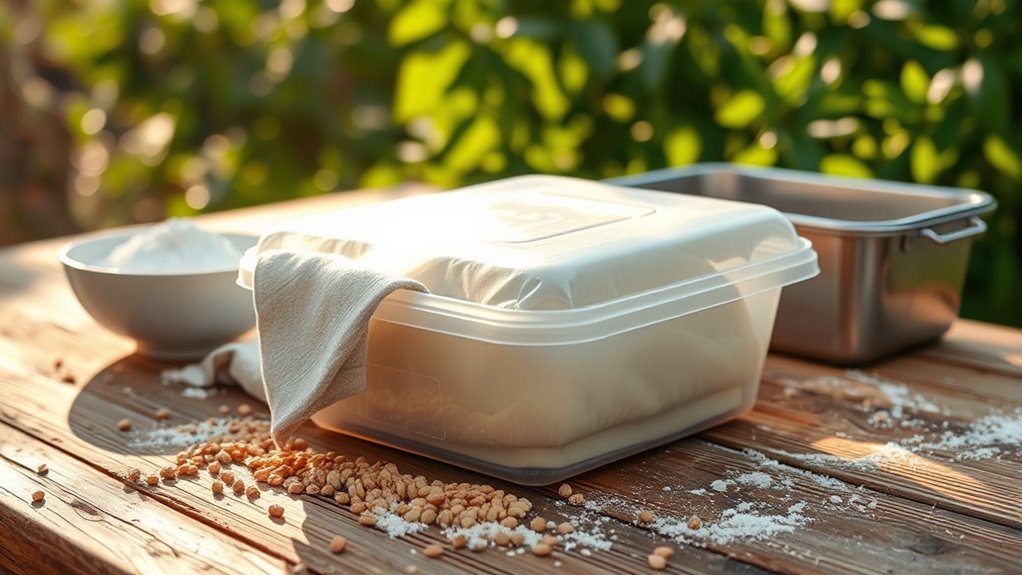
To get the best results, you need to guarantee your dough has the right consistency—neither too sticky nor too stiff. Proper covering techniques help maintain moisture and prevent drafts that can affect fermentation. Ensuring consistent routines during proofing can also provide stability for your dough, making outdoor proofing much more reliable and successful.
Optimal Dough Consistency
Achieving the right dough consistency is essential for successful outdoor proofing, especially when environmental conditions can vary. Your goal is a dough with ideal dough elasticity—neither too stiff nor too slack. Proper fermentation timing plays a key role, as overproofed dough can lose its structure, while underproofed dough won’t expand properly. To gauge readiness, consider this table:
| Dough State | Characteristics | Ideal for Proofing |
|---|---|---|
| Underfermented | Dense, tight, slow rise | Not ideal |
| Properly Fermented | Smooth, elastic, rises well | Perfect for outdoor proofing |
| Overfermented | Flat, overly slack, sour flavor | Avoid |
Monitoring dough elasticity and fermentation timing ensures your dough’s consistency for outdoor conditions. Additionally, paying attention to proofing environment can help optimize results under varying outdoor conditions.
Proper Covering Techniques
Covering your dough properly is essential to safeguard it from outdoor elements and guarantee consistent proofing. Using the right covering materials helps maintain humidity and prevents drafts. For outdoor sheltering, opt for breathable covers like linen or cloth that allow airflow while protecting from dust and insects. Here are four tips to master proper covering techniques:
- Choose lightweight, breathable covering materials to prevent condensation.
- Use a damp towel or plastic wrap for added humidity control.
- Create a stable outdoor shelter using a box or tent to shield from wind and direct sunlight.
- Ensure the cover fits snugly but isn’t tight, allowing airflow without exposing the dough to environmental stress.
- Paying attention to contrast ratio in your shelter setup can help improve visibility and monitor the dough’s condition effectively.
Proper outdoor sheltering and covering materials keep your dough in excellent condition during proofing.
Creating a Controlled Environment for Rising

Creating a controlled environment for rising guarantees your dough stays warm and humid, which promotes ideal fermentation. To achieve this outdoors, consider how outdoor lighting affects temperature regulation—shade can prevent overheating, while indirect sunlight can help maintain consistent warmth. Proper pest control is essential, as insects and critters can disrupt the rising process or contaminate your dough. Use mesh covers or screens to keep pests out while allowing airflow and light to filter through. Avoid direct exposure to harsh elements that can dry out or cool the dough. Using weather-appropriate coverings can help protect your dough from unpredictable outdoor conditions. By managing outdoor lighting and pest control effectively, you create a stable, protected space that encourages proper rising and results in better bread. Stay mindful of these factors to ensure consistent fermentation outdoors.
Tips for Maintaining Proper Temperature and Humidity
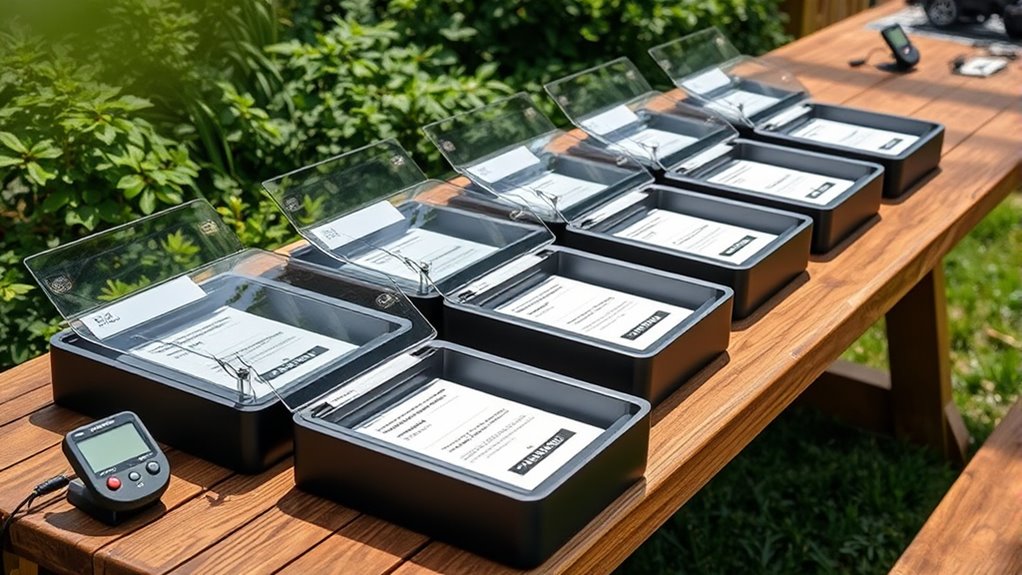
To maintain your proofing environment consistent, you need to regularly monitor temperature and humidity levels. Make adjustments as needed to prevent fluctuations that could affect your dough. Staying vigilant ensures your baked goods rise perfectly every time. Additionally, employing reliable climate control systems can help sustain optimal conditions and reduce manual adjustments.
Monitoring Environmental Conditions
Monitoring environmental conditions is essential to guarantee your proof boxes and outdoor proofing setups stay within ideal temperature and humidity ranges. To do this effectively, keep an eye on several factors:
- Use a reliable thermometer and hygrometer to track temperature and humidity levels constantly.
- Incorporate solar heating solutions to maintain consistent warmth during cooler days.
- Ensure wind protection around your setup to prevent sudden temperature drops and humidity fluctuations.
- Regularly check for changes in weather and adjust your setup accordingly, like adding shade or insulation when needed.
- Remember that climate control methods are vital for maintaining optimal conditions and ensuring the success of your outdoor proofing efforts.
Adjusting for Consistency
Since environmental conditions can fluctuate unexpectedly, it’s important to make real-time adjustments to keep temperature and humidity levels stable. If your proofing environment gets too warm or humid, consider ingredient substitution, such as reducing moisture-rich ingredients or adjusting dough hydration. Additionally, storage considerations play a role; guarantee your proof box is well-sealed and insulated to prevent sudden shifts. Use a thermometer and hygrometer to monitor levels frequently, and tweak your setup as needed—adding or removing humidity sources like damp towels or moisture trays. Regularly checking your proofing environment helps identify issues early. Consistency comes from quick responses and understanding how ingredients react to changes. Regularly evaluating your environment and making small adjustments helps maintain steady proofing conditions, resulting in reliable, high-quality baked goods every time.
Protecting Your Baked Goods From Outdoor Elements
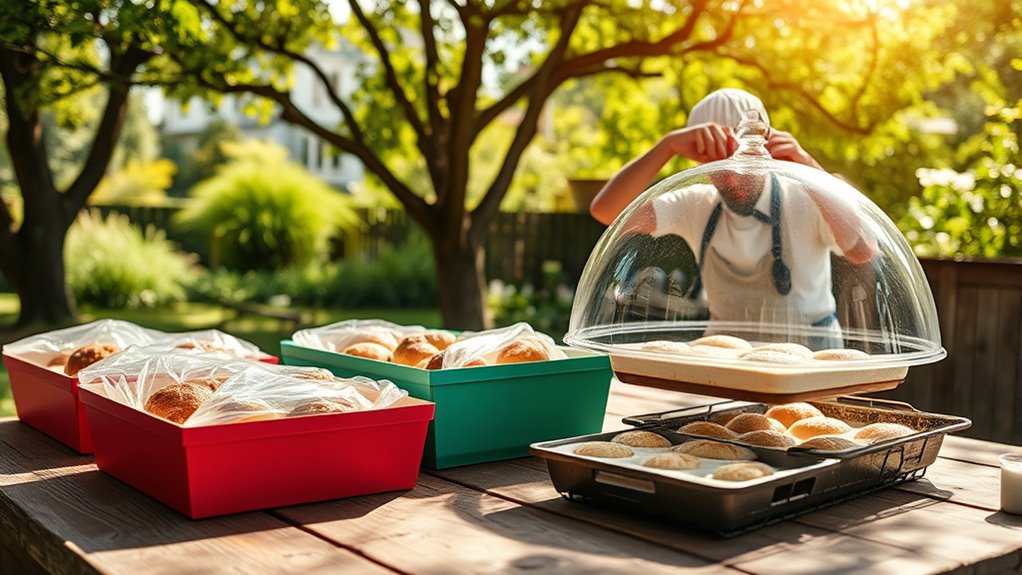
When you’re proofing baked goods outdoors, protecting them from the elements is essential to guarantee they turn out perfect. Wind, sun, and humidity can compromise your baked goods if you’re not prepared. To keep them safe, follow these steps:
- Use sturdy, clean proof boxes or covers to shield against wind and debris.
- Place baked goods in shaded areas to prevent uneven rising or over-baking from direct sunlight.
- Regularly inspect your equipment, ensuring it’s clean and in good condition—this is key to equipment maintenance.
- Set up safety precautions by monitoring weather conditions to prevent sudden changes from ruining your proofing process.
- Understanding environmental factors like humidity levels can help you better adapt your proofing environment for optimal results.
Proper protection guarantees consistent results and keeps your baked goods safe from outdoor elements.
Decorating and Finishing Touches in an Outdoor Setting

Decorating and finishing your baked goods outdoors offers a unique opportunity to showcase your creativity, but it also requires careful planning to guarantee your final touches stay intact. Take advantage of the outdoor ambiance and natural light to highlight details and vibrant colors. Choose a shaded spot or set up a canopy to avoid glare and ensure even lighting. Use the table below to help plan your outdoor decorating setup:
| Element | Tip | Benefit |
|---|---|---|
| Surface | Use a sturdy, flat table with a cloth | Prevents slipping and protects baked goods |
| Lighting | Rely on natural light, add portable reflectors | Enhances details and true color accuracy |
| Decorations | Opt for lightweight, weather-resistant items | Avoid damage from wind or outdoor elements |
| Tools | Keep essential tools within reach | Speeds up decorating process |
| Final Touches | Keep finishing sprays or glazes handy | Adds shine and polish outdoors |
Troubleshooting Common Outdoor Proofing Challenges
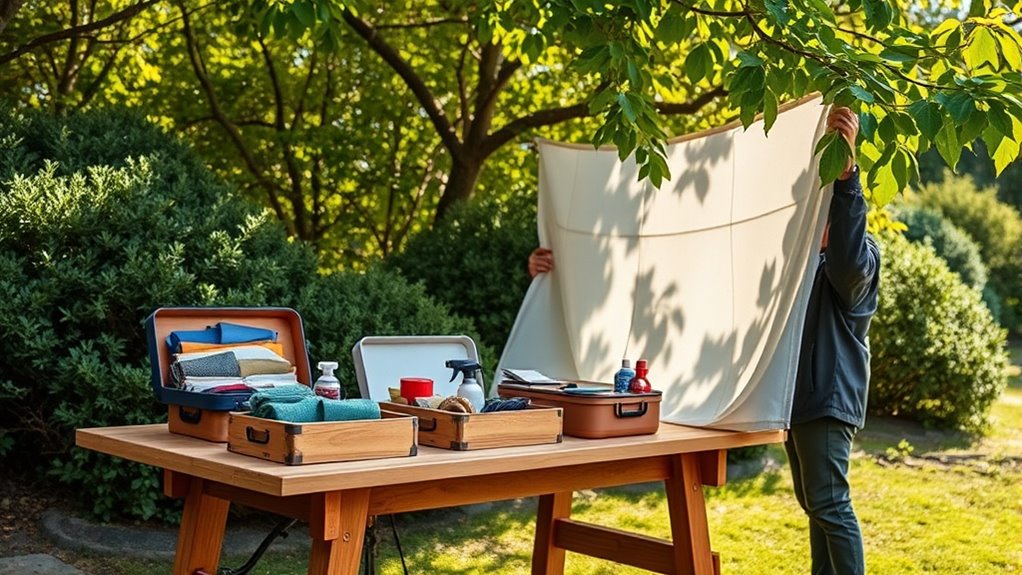
Outdoor proofing can present several challenges, especially with unpredictable weather and environmental factors that can affect your dough’s rise and texture. To troubleshoot, first confirm your proofing environment stays warm and consistent, even if outdoor conditions fluctuate. If your dough isn’t rising well, consider common ingredient substitutions like adding a pinch of sugar or using a different type of yeast. Next, troubleshoot oven issues by verifying your oven’s temperature accuracy with a thermometer, especially if you’re using it as a proofing box. You can also use a proofing box or a warm spot indoors as a backup. Finally, monitor humidity levels; too much moisture can hinder proofing, so use a damp cloth or adjust your environment accordingly. Understanding city dynamics can help you choose the best outdoor environment for proofing and ensure consistent results. These tips help keep your outdoor proofing successful.
Frequently Asked Questions
How Do I Choose Eco-Friendly Prep Boxes for Outdoor Baking?
To choose eco-friendly prep boxes for outdoor baking, look for containers made from biodegradable materials like bamboo or compostable plastics. Reusable containers are also a great option—they reduce waste and can be used multiple times. Check for durability, leak-proof features, and food safety certifications. By selecting these eco-friendly options, you’ll minimize environmental impact while keeping your baked goods fresh and secure outdoors.
What Safety Precautions Should I Consider When Proofing Outdoors?
Prioritize protection by practicing proper hygiene practices and monitoring weather considerations. Keep your workspace sanitized, wash hands regularly, and cover surfaces to prevent contamination. Check the weather forecast to avoid proofing in extreme heat, cold, or rain, which can affect dough quality and safety. Use breathable covers or tents for safeguarding, and ensure a clean, safe environment. Staying vigilant helps prevent pitfalls and promotes perfect proofing outdoors.
Can Outdoor Proofing Affect Different Types of Dough Uniquely?
Yes, outdoor proofing can affect different dough types uniquely. You need to regulate temperature and manage humidity carefully, as some doughs are more sensitive than others. For example, high humidity can make enriched dough overly sticky, while temperature fluctuations might slow or speed fermentation. Adjust your environment accordingly, using insulation or coverings, to guarantee each dough type proofs properly without unintended effects.
How Do I Prevent Pests From Contaminating My Baked Goods Outside?
To prevent pests from contaminating your baked goods outside, you should implement pest deterrent strategies like using tightly sealed outdoor storage solutions. Keep your baked items in airtight containers or prep boxes with secure lids, and store them in a clean, elevated area away from pests. Regularly clean your workspace, remove crumbs, and consider natural repellents like herbs or citronella to further deter pests from approaching your baked goods.
What Are Eco-Friendly Options for Decorating Baked Goods Outdoors?
You can opt for eco-friendly decorating options like using natural ingredients or edible flowers instead of plastic decorations. When packaging, choose biodegradable packaging and reusable containers to minimize waste. These options not only reduce environmental impact but also add a charming, rustic touch to your baked goods. By combining creative decorating with sustainable packaging, you make your treats both beautiful and environmentally responsible, impressing your guests and helping the planet.
Conclusion
Just like Icarus learned when he flew too close to the sun, pushing your outdoor proofing limits can lead to setbacks. But with the right prep boxes and environment control, you’ll soar confidently through each bake. Embrace the journey, learn from the challenges, and trust your instincts. Before long, you’ll be mastering outdoor baking like a seasoned artisan, turning every rise into a demonstration of your skill—and a delicious victory worth celebrating.









